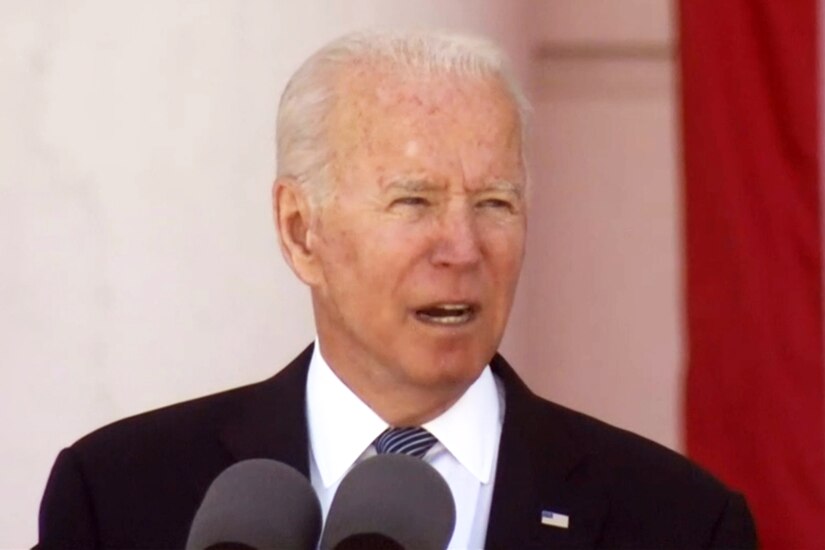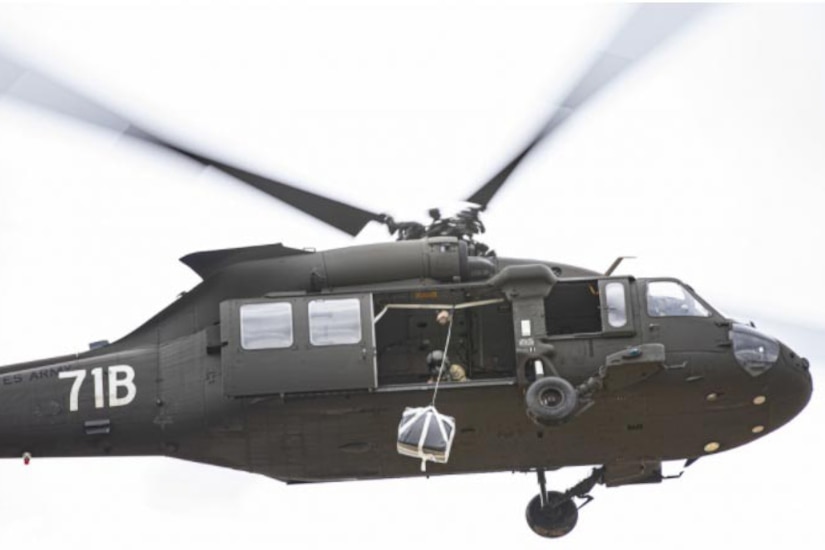Navy Vice Admiral Jon A. Hill, director, Missile
Defense Agency; Michelle C. Atkinson, director for operations
STAFF: Ladies and gentleman -- ladies and sir -- hey
guys, welcome to the Missile Defense Agency's briefing on our portion
of the president's budget for fiscal year '22 -- 2022. On my left are
your briefers today. Vice Admiral John Hill is the Director of the
Missile Defense Agency, and Miss Michelle Atkinson on his left is the
Director for Operations for the Missile Defense Agency.
We'll go through a brief slide deck, and then the Admiral and Ms.
Atkinson will take your questions. When the Q&A begins, please wait
for me to call on you, and please identify yourself and your outlet when
we do so. And I'll ask the Admiral to begin.
VICE ADMIRAL JON A. HILL: Okay, thanks Mark. Good afternoon
everybody, thanks for staying late for us on a Friday before Memorial
Day weekend. It's great to be here. Again, I'm John Hill, the Director,
and my Director for Operations who also owns a human resources and
facilities and budget, is the good Michelle Atkinson, and she'll walk
you through the brief and then we'll take questions afterwards. So, over
to you Michelle.
MICHELLE C. ATKINSON: Thank you, Admiral. Good afternoon everyone, I
know that we are the only thing standing between you and a three day
weekend, so we'll be -- we'll be quick here. I appreciate the
opportunity to brief you today on the Missile Defense Agency's FY '22
budget request. Next chart please. Our current missile defense system
can defeat today's ballistic missile capabilities of our adversaries.
However, the threats posed by both ballistic and non-ballistic
systems from rogue nations and strategic competitors can deter -- can
used -- in gross -- increase and grow in complexity. There are several
trends with respect to the nature of this growing threat worth noting.
First, ballistic missiles continue to proliferate, and will be a
threat in future conflicts involving U.S. forces. Ballistic missiles
have been used in several conflicts over the past 30 years, and will
continue to be used.
Second, adversary ballistic missile systems are becoming more
sophisticated. Their systems are becoming more mobile, survivable,
reliable and accurate, and can achieve longer ranges. New ballistic
missile systems also feature multiple and maneuverable reentry vehicles,
along with decoys and jamming devices.
Third, as recently emphasized by Secretary Austin, the lines between
ballistic and non-ballistic missile threats have become increasingly
blurred, as we are seeing with the new hypersonic missile threats.
Hypersonic glide vehicles delivered by ballistic missile boosters are an
emerging threat. These threats can travel at exceptional speeds with
unpredictable flight paths. This poses new challenges to our missile
defense systems.
Fourth, the cruise missile threat to our U.S. forces is increasing.
The majority of land attack cruise missiles will still be subsonic, but
supersonic and hypersonic missiles will be deployed in the future. Land
attack cruise missiles will also have increased survivability by
minimizing radar signature and also the use of countermeasures.
These are the challenging realities of the emerging missile threats.
U.S. missile defense policy, strategy, and capabilities must continue to
evolve in order to address these threats. The Missile Defense Agency FY
'22 budget request addresses these realities as I will discuss
throughout this briefing. Next chart please.
The Missile Defense Agency mission remains unchanged. Our missile
defense capability must be able to address the full spectrum of missile
threats, both ballistic and non-ballistic. The continual improvement of
our missile defense system is especially critical.
Without further development and technology investments, our current
system will not have the capability to address the more advanced threat,
such as the cruise missiles and hypersonic glide vehicles I spoke of.
Next chart please.
The agency's foundations are focused on delivering missile defense
capability to our war fighters, and the FY '22 budget request reflects
this commitment. This request continues to operate and maintain our
fielded systems, such as ground-based midcourse defense, AEGIS, and
THAAD to the highest level of system readiness and reliability.
This budget continues to produce and field missile defense cap --
capacity to address the expanding threat, including delivery of
additional interceptors and radars.
Finally, this budget prioritizes investments in new capability
development and advanced technologies to address the emergence of a new
and more advanced threat I spoke of earlier, with efforts such as the
hypersonic and ballistic tracking space sensor, or HBTSS, hypersonic
defense, and the next generation interceptor, or NGI. Next chart please.
Our total request of $8.9 billion FY '22 strengthens and expands the
deployment of defenses for our nation, our deployed forces, allies, and
international partners against increasingly capable missile threats. Of
the $8.9 billion FY '22 request, $7.2 billion, or 80 percent of our
budget, is for research and development efforts.
This budget request balances the numerous requirements and priorities
against available budget. Our FY '22 budget request is only slightly
lower than the FY '21 budget request of $9.1 billion. Our procurement
budget request is slightly lower this year as we prioritize development
of new capabilities in order to counter the emerging missile threats.
Next chart please.
This chart outlines the highlight of the FY '22 budget request. This
request allows us to maintain operations and readiness of deployed
missile defense systems, and also our C2BMC network. This request also
continues production and fielding of missile defense capability and
production of additional SM 3 block 1B and 2A missiles for the Navy, and
THAAD interceptors for the Army.
Finally, in response to the increasing threats I spoke of earlier,
this request includes several development and technology efforts.
Examples of these development efforts include the hypersonic and
ballistic tracking space sensor, development on which we are working
very closely with the U.S. Space Force and the Space Development Agency.
This budget fully funds the next-generation interceptor program to
maintain two industry teams through the critical design review. We
awarded two contracts in March of this year to this important Homeland
Defense program.
This budget also requests funds for the development of a regional
hypersonic defense glide phase intercept capability. In response to a
request from INDOPACOM, the budget request also includes funding for the
defense of Guam. The next set of charts will address some of the
specific budget line items in the missile defense agency's FY22 budget
requests. The charts are an order of the missile defense system battle
sequence - detect, control, and engage. Next chart, please.
As I mentioned earlier, in coordination with U.S. Space Force and
SDA, we are developing a hypersonic and ballistic tracking space sensor.
This capability meets critical Warfighter requirements and provides
fire control quality data to track dim ballistic threats and global
maneuvering hypersonic threats. The program is focused on deploying the
first two satellites in FY 23. The Space Tracking and Surveillance
System, or STSS, remains in orbit now, supporting DoD and the
intelligence community.
The budget request supports the passivation of these two STSS
demonstration satellites, which operated well beyond their expected
service life and provided the foundation for future space-based sensor
capability to include HBTSS. We are developing, deploying, and
sustaining ground-based radars to counter current and future missile
threats, build Warfighter confidence, and increase force structure. The
FY22 budget request includes upgrading and sustaining 12 AN/TPY-2
radars, with a 13th radar being procured now with FY 21 funds from
Congress. Completing and fielding the Long Range Discrimination Radar,
or LRDR, in Alaska.
LRDR construction continued this year despite a temporary work
stoppage that lasted several months because of steps taken to mitigate
the spread of COVID-19. This advanced radar is a critical midcourse
sensor that improves the missile defense system threat discrimination
capability and also allows for more efficient use of the ground-based
midcourse defense system. The Sea-Based X-Band Radar, or SBX, provides
precision midcourse tracking and threat discrimination to protect our
homeland.
The FY22 request continues operations in support of this critical
radar. We will continue to sustain and provide updates to the Upgraded
Early Warning Radars or UEWRs and continue to Cobra Dane radar
refurbishment and life extension effort in partnership with the U.S. Air
Force. C2BMC is the integrating element of our missile defense system.
The FY22 budget request sustains the fielded C2BMC capability across 18
time zones with hardened networks supporting all of the combatant
commands. The budget request also integrates new capabilities into
C2BMC, such as LRDR. Next chart, please.
The department is committed to improving U.S. homeland missile
defenses to counter limited missile threats from rogue states. The
Ground-based Midcourse Defense system, or GMD, serves as a continuously
available homeland missile defense capability for defending against
today's rogue state ballistic missile threats. To ensure continued
operability of the GMD system, we have requested funding to continue
with the service life extension program that will include upgrades and
replacement of ground system infrastructure, fire control, and
co-vehicle software to improve reliability, capability, capacity,
availability, and cybersecurity. The request supports the currently
deployed Ground-Based Interceptors, or GBIs, and completion of the
additional missile field in Alaska to enable future fielding of the next
generation interceptors.
As I mentioned earlier, the FY22 budget request includes funding for
two NGI industry teams through the critical design review. This plan
reduces technical risk, secures competitive production pricing, and
creates incentives for early delivery to the Warfighter. The Aegis
missile defense request continues to upgrade the Aegis Weapon System and
procure additional missiles. 40 Aegis SM-3 Block IB missiles and eight
SM-3 Block IIA missiles will be procured for deployment on land at the
two Aegis Ashore sites in Europe and at sea on multi-mission capable
Aegis ships.
Our request continues the multi-year procurement for the SM-3 Block
IB missile. We will continue to develop and implement Aegis Weapon
System upgrades to support the Navy's newest Destroyers with the new
SPY-6 radar, as well as upgrade sensors on the older ships in the Aegis
fleet. Currently, construction is over 90% complete at the Aegis Ashore
site in Poland. Jointly with the Army Corps of Engineers, we recently
installed four SPY radar arrays and the fire control system there. Aegis
weapon system installation and checkout have also commenced.
The THAAD weapons system is a globally transportable ground-based
missile defense system, which is highly effective against short-range,
medium-range, and intermediate-range threats. In FY22, we will procure
18 THAAD interceptors, obsolescence mitigation efforts, and training
support. We will also continue the development and integration of
multiple independent THAAD software builds to address the evolving
threat, improve the Warfighters defense planning and improve system
capability. The FY22 budget request includes funding to continue testing
of THAAD and Patriot interoperability to improve the overall missile
defense capability and increase the defended area. As I mentioned
earlier, we were responding to requests from INDOPACOM to begin the
development of a defense of the Guam system. Next chart, please.
The FY22 budget request includes investment in innovative
technologies to address the emergence of new and more advanced threats.
The budget request continues our advanced research program to explore
innovative and disruptive technologies and also to develop emerging
capabilities to enhance our missile defenses. This budget also includes
funds for system engineering to continue to provide critical products
and processes needed to combine element missile defense capabilities
into a single, integrated and layered system. Testing is a critical
aspect of the Missile Defense Agency mission. Validating system
performance through flight and ground tests is paramount to building
Warfighter confidence in our system.
To that end, the FY22 request includes flight, ground, and
cybersecurity testing and the development of threat representative
targets used during testing. FY22 test highlights include FTX 26, which
is the LRDR Operational Acceptance Test, and FTM-46 which is required
for the SM-3 Block IIA missile full-rate production decision. We are
taking steps to develop and deliver regional layered hypersonic defense
capability to the Warfighter. We are developing a glide phase intercept
capability for a future demonstration, leveraging our existing missile
defense systems.
In response to USNORCOM's requirement for cruise missile defense of
the homeland, the FY22 request includes funding to develop the systems
architecture and to conduct a demonstration of cruise defense
capabilities using the joint tactical integrated fire control
capability. Missile Defense Agency and the Israel Missile Defense
Organization continue to cooperate on engineering, development,
co-production, testing, and fielding of the Israeli missile defense
system. The FY22 funding request remains consistent with a memorandum of
understanding between the United States and Israel. Next chart, please.
In summary, the Missile Defense Agency's FY22 budget request is $8.9
billion. An important part of the department's strategy to defend the
nation, this budget request prioritizes funding for the development of
new capabilities to counter the expanding threats. This budget request
continues the development, rigorous testing, and fielding of reliable,
increasingly capable state-of-the-art missile defenses. It focuses on
the readiness, capability, and capacity of fielded homeland and regional
missile defense systems. The FY22 budget request enables the Missile
Defense Agency to outpace future offensive missile systems in order to
defend the United States homeland, our deployed forces, our allies, and
international partners.
Thank you. The admiral and I will now take a few questions.
STAFF: Steve, lead us off, please.
QUESTION: So back in February, MDA published an RFI for a pulsed
laser that could be air or space, or even ground operated. So is
anything like that in the fiscal 2022 budget? Or if not, where do you
see that going? And also, for that matter, air-launch kinetic intercept,
if that's in the FY22 budget anywhere?
ADM. HILL: Yeah, the second one I know is not in the budget. I do
remember when we put out the pulse laser work, and that was to get that
feedback from the industry for potential investment in the future.
Michelle, do you have anything to add?
MS. ATKINSON: We also received an FY21 congressional toss-up for the DPAL laser program.
QUESTION: That was supposed to be eliminated last year, but I didn't realize there was a plus-up? Oh, OK. I see.
STAFF: Sandra?
QUESTION: Thank you. Can you clarify what is the request for BBTSS
and for SKA? You had it in the chart, but I couldn't tell there. There
were two numbers there.
MS. ATKINSON: OK. So the -- let me find it. The HBTSS budget request is roughly $260 million this year.
QUESTION: OK. So and then SKA was $32 million? Is that what...
MS. ATKINSON: No, it was what the other number was.
QUESTION: OK. So does that funding fund the two prototypes, the two
satellites? And do you plan to downselect and only launch one satellite?
Or do you plan to launch both?
ADM. HILL: Thanks, a great question. You're talking specifically
about hypersonic ballistic tracking (space) sensors. So yeah, HBTSS is
on the path to launch two interoperable satellites that are built by two
separate industry partners. So the idea is to keep competition in
early, given the complexity of the mission. It is the only program
within the space portfolio that provides fire control quality data down
to a weapon system like Glide Phase Interceptor.
QUESTION: And are these payloads going to be also the payloads that SDA will use in the tracking layer?
ADM. HILL: They'll be interoperable with the tracking layers. So if
you look at the overall architecture, what SDA is doing with the
transport layer, and what they're doing with a wide field of view, a
queuing source for HBTSS as an example, they're connected that way, but
they are separate.
QUESTION: So, you will not be developing payloads for them. Will they be doing their own payloads?
ADM. HILL: Yes. We have different missions, and so each HBTSS fire
control, wide field of view for early warning that would then queue
those satellites. So they're connected within the architecture, but they
are separate.
QUESTION: OK. Thank you.
ADM. HILL: Thank you.
STAFF: And let's go to our online folks. Do you have a question?
QUESTION: Yeah, thanks for doing this. I just wanted to clarify. I
see the MDA requested $248 million in defenses against hypersonic speed
weapons, and you mentioned the Glide Phase Interceptor. But are there
other projects within that $248 million, or is that all for GPI?
ADM. HILL: Do you want to talk about it?
MS. ATKINSON: Yeah, so GPI is the majority of that funding. We also
have engineering, and we're starting to plan for the targets and testing
of that capability in the future.
QUESTION: Thank you.
STAFF: Okay, Jen, please.
QUESTION: (inaudible) I wanted to ask a little bit more about
defense of Guam effort. Is that now sort of in lieu of -- I know
originally you were looking at a radar at -- somewhere in the Pacific, a
Hawaii radar. They were talking about like a 360 Aegis Ashore-like
capability. What are you looking at for Guam, a defense of Guam
capability? And what's on the timeline, it looks like you're investing a
$100 million on that, but if you can give a little more detail on what
the architecture may be looking like for this effort (inaudible)
ADM. HILL: So we're not really positioned to do that yet. So you
referred a little bit to what's in the INDOPACOM Pacific defense
initiative. So, there's that and the request from INDOPACOM, but right
now we're in the middle of doing that architecture analysis with the
CAPE and with the joint staff and others to make sure that we have the
options on the table, so that we can make use of the resources that we
have to give the best defense possible for Guam. And so we're working
through that now.
And part of that -- the real focus on those dollars in the '22 budget
is to do things like spectrum analysis in the area because we know we
the sensing capability. We know that we have varying topology there
across the island so how would you place those sensors? Where would the
fire control systems go? Where would the weapons go? So there's work
there and there's likely some long lead material items that we'd want to
procure. But we're keeping that option space open now within the
Department until we've come through all of those trades.
QUESTION: OK. Can you provide a little more detail in terms of what
systems might be on the table in terms of what you're looking at? I
mean, especially if you're already looking at long lead items I'd
imagine you have some sense of maybe where you want to go?
ADM. HILL: Sure. Yes. What I think we'll do, and I say I think
because it's still in the trade space, but we're going to focus heavily
on the regional systems today that are prudent, that have program of
record that can be evolved. And so when you look at that, there's a
fair amount of capability by which we can construct a really great
architecture. We're just doing that work now and this funding helps us
to robustly go after that so we can meet the timeline.
QUESTION: OK. Are you hoping to have a more fleshed out plan of this, you know, by some time in FY '22…
ADM. HILL: Yes.
QUESTION: …so then you can fund a path forward more robustly in FY '23? Is that sort of the plan?
ADM. HILL: Yes. Yes. That's -- that is the plan.
STAFF: OK. And let's go back to our remote audience. Mr. Peter Loewig.
QUESTION: Hi, thanks very much. My Guam question got covered, so
can you talk about other -- are there other -- are there other missile
defense initiatives in the Indo-Pacific? And then specifically because
Aegis Ashore has been mentioned so much with Guam, has there been
anything done to reflect the fact that the Japanese public has slowed,
delayed, stopped, the Aegis Ashore in Japan?
ADM. HILL: Great -- great question. So, I'll answer specifically to
the missile defense for Japan. We're working very closely with the
Japan Ministry of Defense to assess options. And you're absolutely
right, a decision was made by the government of Japan to no longer
pursue the two Aegis Ashore sites.
And so what we're doing now is answering questions for the Ministry
of Defense to help them make their decision on what the configuration
would be for the equipment that they have procured through FMS and
through the direct commercial sales programs tied to Aegis Ashore, but
how can you take those and make them sea based. So that's in the
Japanese trade space now and we're in full support.
QUESTION: Thank you. And no other -- no other missile defense elsewhere in the Indo-Pacific in this request?
ADM. HILL: If you -- if you look at the details of the capability
that we bring forward into Aegis ships as an example, and when we talk
about the investments going towards a hypersonic missile-defense
regional glide based capability, that would have a contribution in the
-- in the INDOPACOM theater, HBTSS as a space asset. When we get those
two satellites built by two different companies into space in the '23
timeframe, they're meant to be in an operational position. We will use
those up for testing in the region initially and based on the how we
characterize their performance they could be used operationally.
QUESTION: Great, thank you very much.
ADM. HILL: Great, thank you.
STAFF: Jen, please.
QUESTION: So what's not super clear in the document that we've
received so far on the budget is your plans for the homeland where, you
know, looking at potentially incorporating that or you just -- some of
these other systems? So could you walk us through how that is taking
shape for you now and what we might be able to expect in FY '22 budget
for potential plans for this?
ADM. HILL: So for '22 that -- the real focus would be to pick up
where we -- we did a feasibility test for FTM-44, an aegis ship engaging
an ICBM outside the requirement space, so operated outside the combat
system's requirements space, outside the missile's requirement space.
It was a congressionally directed test to be done last year, we
completed that in November. And so what that does is that now, you
know, leads you to questions about how would the system perform against a
more complex type target.
So when you look into the budget, which you'll see is that look at
the command control battle management, what would it take to bring
together the homeland defenses and incorporate an Aegis capability?
What can be done within the THAAD program, terminal high altitude air
defenses system, and how would you link all those together to give
options to the combatant command?
Those decisions have not been made to-date, what we're really doing
is coming through the feasibility and the technical approaches of
bringing those together as a layered homeland defense perspective.
QUESTION: OK. So in FY22 we would -- the funding to look at this would be in terms of the things you mentioned.
ADM. HILL: Yes.
QUESTION: OK.
STAFF: And let's go to our remote audience, Jason Sherman from Inside Defense please.
QUESTION: Thanks. Hill, I wondered if you could say a little bit
more about the Hypersonic Defense Program and walk us through this shift
that MDA when through when thinking with the -- the program that you
kind of re-designed and then sort of repackaged as the GPI. Could you
talk to us about the timing of that program and your efforts to
accelerate it? Sort of what -- what's the -- what -- what -- what was
the -- the time that -- that -- that you -- under the old program? What
is the target for fielding under the new program? And could you say
something about the interceptors?
Will you basically be using off-the-shelf or a modified variants of
what already available for that in the first iteration and then going to
a completely new design for something further down the road? And --
and -- and when does the terminal capability begin to come online? I'm
-- I'm -- I gather that's not in this budget but you have a request
(inaudible) industry. So you could talk us through all of that, sort of
the change for the program, what interceptors the interceptors are that
you -- you are looking at the near-term, far-term, and yes, thanks.
STAFF: Let’s just let him go ahead and get to those questions...
ADM. HILL: You know, Jason, I thought you did a great job outlining
the -- the strategy. So -- so the way I'll answer it is I'll kind of
give you a sense of where we are today and then I'll kind of walk you
forward, all right.
So -- so where we are today from a protection of sea base, Sea-Based
Terminal, you mentioned that. And that's tied in and controlled by the
Aegis Combat System, leveraging off-board sensors to protect the
high-value units set within the sea base. That -- that capability is
designed to handle what I will call the advanced maneuvering threat,
right. So that's sort of that first layer of defense against
hypersonics - a pretty important capability.
Now, how do we build on top of that? Where we were a couple years
ago, it was a science and technology focus that the Regional Glide Phase
Weapon System -- so when we say weapon system that covered everything
from sensors through fire control through weapons systems -- and what
technology needed to be matured.
So when you're in the glide phase -- which is higher up from the
terminal, right, where a hypersonic vehicle is likely in its most
vulnerable phase -- that's actually a pretty tough environment to be
in. And you can't take an air defense weapon and operate it there nor
can you take a space weapon like an SM-3 and operate there, it's just a
different environment.
And so we are risk-reducing and maturing technologies to operate
there -- things like seekers and coatings and materials for operating in
that area, propulsion techniques, divert techniques. That was the
focus of that and it was a much longer term -- you know, it wasn't set
for transition into a firm development program so that would have
delivered something for hypersonic defense in the glide phase out in the
'30s.
So based on real-world data collections, we were able to take our
system models, Aegis models, sensor models, ground-based systems and run
the -- the data collected from actual live fires. And we found that we
can close the fire control loop with an Aegis ship that has already
proven queuing launch-on-remote and engage-on-remote capability.
So what the ship needs is an early look at a threat flying through
the glide phase and leveraging its engage-on-remote or launch-on-remote
capabilities in order to have -- and build that track. Then it needs a
weapon to get there.
So when you talk about that change from the Regional Glide Phase
Weapon System into, now, the Glide Phase Interceptor program, in order
for us to accelerate and deliver something faster -- because that threat
exists today, as you know -- we have the terminal system, the Sea-Based
Terminal which is in a state of evolution that's got more increments
coming downstream to get even better at what it does, but we want to
engage further back into the trajectory, into the glide.
So we looked at a number of different propulsion systems and
front-ends and we released a broad area announcement recently. And we
just received the industry responses to that and so we'll be evaluating
those. And so I can't give you a firm timeline on what the acceleration
is until we evaluate the industry concepts and then move forward.
What we're really doing in '22 is preparing ourselves for a very firm
Systems Requirements Review. So what -- what we get from industry
today helps us to set those requirements and get them right before we
commit towards going to a more -- you know, a development program.
And so I think that may answer your question, I'll just give you a
couple more. So if you understand where we are today, where we want to
go in the future from a weapons perspective -- we talked about HBTSS,
right -- so right now we can leverage seaborne sensors, we can leveraged
land-based sensors, we have incorporated the ability to track
hypersonic threats, but as you know it's a globally maneuvering kind of
threat so you need to be up in space looking down.
So in coordination with Space Force and with SDA -- you know, the
question going back to the use of the Transport Layer and the great work
that SDA's doing for communications, you know, within the low-Earth
orbit -- we're going to have a very robust and resilient space capacity
to get data down to that ship from space if we can't catch it with our
land-based or sea-based sensors.
And so, HBTSS, C2BMC moving data to weapons systems, initially Aegis
ships, we want to make sure that what we do within the confines of a
Mark 41 Vertical Launching System for a ground -- for a Glide Phase
Interceptor can be transported and be used at a land-based battery.
So Jason, how's that for a long answer to your long question?
QUESTION: That's great. And just...
ADM. HILL: OK.
QUESTION: ... when does the terminal program begin to kick-in?
ADM. HILL: The terminal program is deployed today and -- and is
continuing to test. And there is a future increment to that program,
but that is funded and in development. And -- and it's in the -- it's
in the '22 budget and it's continuing.
QUESTION: Great. And you've got a cruise missile defense architecture line in the budget this year.
ADM. HILL: Right.
QUESTION: When -- when you look out beyond '22, when are you looking
to -- ideally to deliver a capability for U.S. NORTHCOM -- Northern
Command on that?
ADM. HILL: So I'll -- I'll stick to the PB22 story today which is
really to continue our work with NORAD and NORTHCOM to, you know, build
out that architecture. So I'm not at liberty today to talk about
timelines.
QUESTION: Great. Thank you.
ADM. HILL: Thanks, Jason.
STAFF: OK, any other questions here? Dan or Peter, any further questions on your end?
QUESTION: Do I have the floor? Sorry.
STAFF: I -- I -- who is this?
QUESTION: This is Jason Sherman, sorry.
STAFF: Hey, Jason. Did you have another question? Go ahead.
QUESTION: Yes, if there aren't any others. Admiral, I wonder if you
could talk about this -- this funding that you are seeking for
long-lead items and studying a defensive system for Guam. As the
material developer, are -- is MDA on track to potentially deliver a
capability by 2026, as INDOPACOM has said they need this by?
ADM. HILL: Yes, well, I would say it's -- it's -- it's broader than
MDA. So it is a department-level decision so I don't want to get out in
front of the department on -- on where we're going.
But when we talk about long-lead items, if you look at the
architecture that you discussed earlier that was Aegis-focused, if you
look at other architectures that are being considered, what we're
looking for is the commonality in those in -- in '22 for -- for long
lead. And there's -- there's lots of commonality.
When I say regional systems, right, there's -- there is a set of
regional systems that, you know, we have options to deploy to Guam. So
the idea is to look at these differing architectures. And right now, if
you see commonality in those areas on things that we can procure to
accelerate that timeline to hit that timeline then we'll want to move
out and do that in '22.
QUESTION: Great. And I just want to pick up on the question that
Jen asked about the -- the homeland defense underlayer. Is it -- is it
-- is it fair to characterize that as basically on the backburner? That
-- I mean, last year it was -- it was the centerpiece of your budget
request but it has not found favor in -- you know, in the enterprise,
shall we say, and no longer a priority.
ADM. HILL: I wouldn't say it's no longer a priority, since -- since
we do have investment in the budget. But there -- there are some very
serious policy implications, and so we want to make sure that we get the
policy angles right.
We want to make sure that it's still a need for NORTHCOM because what
we've been able to accomplish in '21 -- and Michelle mentioned the
Service Life Extension Program. You know, the big concern back when
layered homeland defense was first discussed was the concern that the
existing fleet would start to lose its reliability over time while we
also had this timeline for next-generation interceptor off to the
right.
Two big things, now we have a Service Life Extension Program and
we're moving out there and that will increase and give us a
hardware-based data capacity to really understand reliability. You
know, where we were back when we had this conversation last year or year
before was that it was purely analytical. And so it was arguable as to
whether that reliability was going to fall off or not, and how early,
right. So you always assume worst-case.
But now we're going to have real hardware because we're going to
remove interceptors from the ground, we're going to upgrade propulsion,
we're going to update one-shot devices, we're going to update the
processors, update the threat categories, and if that makes those older
missiles perform like the newer missiles, and so reliability goes up,
capacity goes up when you do that.
And so you start to close the gap, and NGI and the competitive award
with two great companies moving forward with the number one requirement
coming from the JROC being speed and schedule we're now being able --
we're going to pull in that timeline on first in placement, for example,
which means we'll be testing a little bit earlier.
And then with the reliability moving to the right we may close this
gap to where the policy decision could be this is great the work that
we've done with FTM-44 and what we'll do with the future tests, and it
helps to make the regional systems more robust and we may not have to do
the integration work in order to do the layered work. So that's really
where we are today.
QUESTION: Great. Thanks.
ADM. HILL: Great.
QUESTION: You mentioned that NGI potential accelerated fielding,
what -- you know, 2028 has been the date that was on the wall, and is
there -- in your estimation, now that you have these two companies under
contract developing this, what's the soonest possible date that you
think they could deliver?
ADM. HILL: So Jason, I know it's been proposed, and it's a
competitive -- make sure as we're running through we have two separate
program offices firewalled away and all that. And -- but I'm a ‘you've
got to show me’ kind of guy. So we just got started, right? We just
made the awards, the teams are just coming together.
I think it's too early for me to declare that I believe those
schedules yet, right? I want to see them hit the knowledge points that
we have in the contracts to prove to us that they are in fact delivering
what they said they will deliver. It's a really complex threat set,
there's a lot of complex technology coming forward. And so I want to
hold on answering that question until we come further down the path.
QUESTION: (Inaudible) General.
ADM. HILL: All right. Thank you.
All right, Jen, you have one final one? We're coming up to four minutes left, so (inaudible).
QUESTION: So just, on the top line, I mean, $8.9 billion a year ago
your request was for $9.2 billion, I believe. Congress gave you another
$1.3 billion, so I'm just curious -- obviously Congress thought you
needed more funding and now you're looking at a budget that's just ever
so slightly lower than your request. So can you talk a little bit about
why you don't need to maybe kind of align with what Congress is giving
you a year ago in terms of just ensuring that you are aligning with the
strategy and things that Congress was concerned with?
MS. ATKINSON: Well first of all, I'd like to say that Congress has
been very supportive and generous to the Middle Defense Agency mission
over the past few years, and we greatly appreciate that. Our FY22
budget request represents the best balance of -- like I said all those
requirements and priorities across the entire department as well as the
available resources across the department. The department had to make
really hard decisions this year as briefed earlier in today's
briefings.
We feel that the Missile Defense Agency FY22 budget represents the
best balance of all those things within the top line that Defense
Missile Agency has. We can still -- even with the $8.9 billion that
we've requested we can fill, maintain, and support the readiness and
availability of the systems that are fielded. We can still procure and
deliver capacity to our war fighter, and as I mentioned we've
reprioritized funding to be able to develop and expand on these new
capabilities to get at the emerging threats.
QUESTION: Will you sending an unfunded requirements list to the Hill this year?
MS. ATKINSON: We're still determining that. We have not yet submitted anything to the Hill.
STAFF: And I think we'll close it up there and let you guys go about
two minutes early and start your long weekend. Thank you all very much
for ...
ADM. HILL: Hey, Happy Memorial Day.
STAFF: ... attending today, and your questions. And have an incredible weekend. Admiral.
ADM. HILL: Thank you, (Inaudible). Thanks everybody, really appreciate it.
MS. ATKINSON: Thank you.
ADM. HILL: Thank you.















